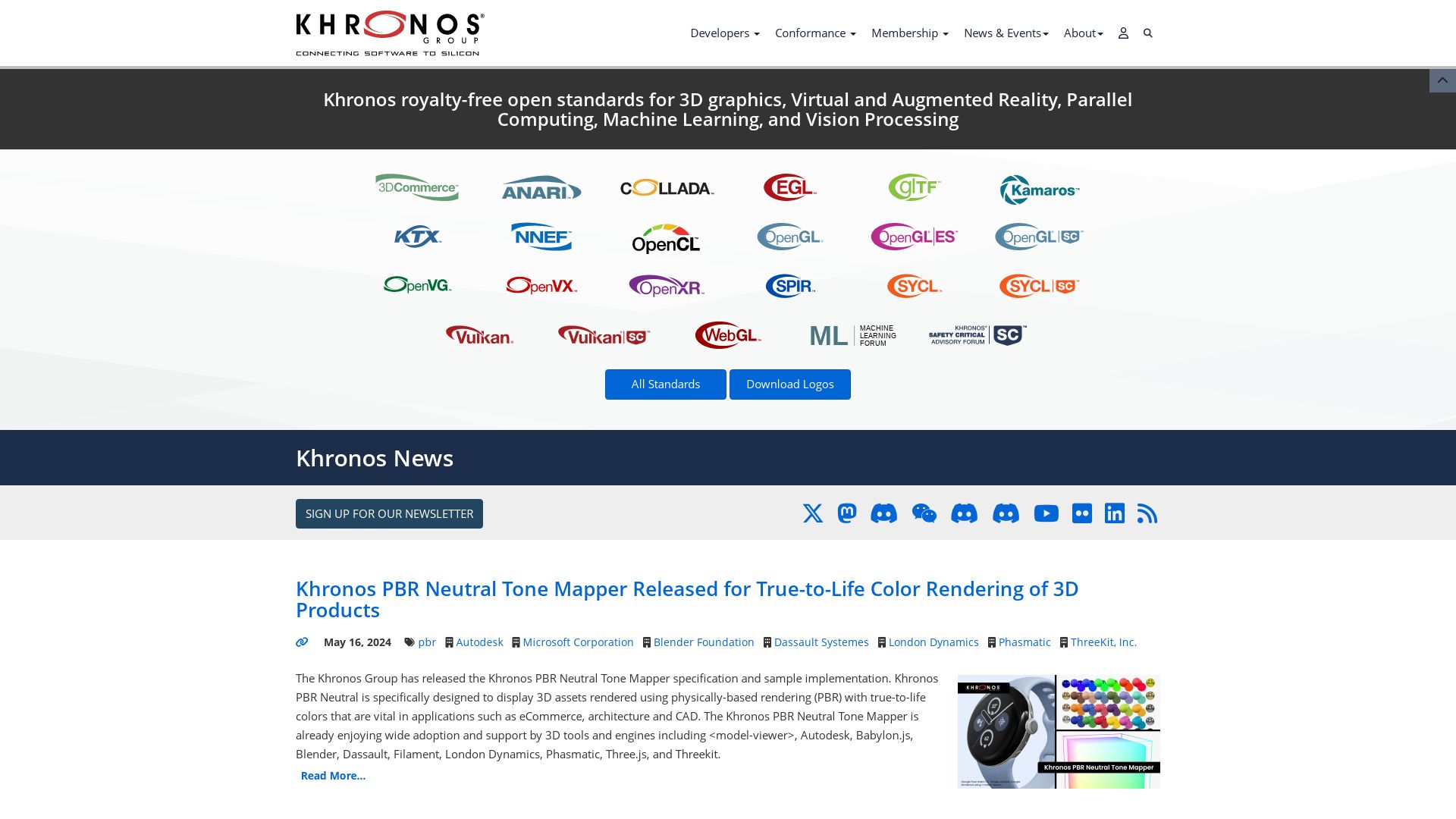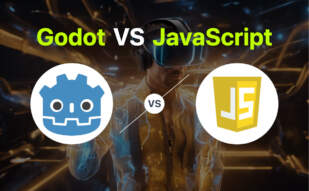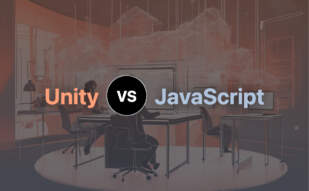
JavaScript
Meet JavaScript, a dynamic and object-oriented programming language known for its light weight and high utility in web development. Embedded in popular browsers since the mid-90s, JavaScript has evolved from its roots in Netscape to power interactive functions and HTML content across the web.
JavaScript Top Features
- Dynamic and interactive: JavaScript enables client-side interaction, offering immediate feedback to visitors for enhanced user experience.
- Network-centric design: Built for crafting network-centric applications, JavaScript facilitates web page interactivity and browser control.
- Wide usage: JavaScript is used by the likes of Facebook, Twitter, Netflix, and Google, and powers 97% of all websites today.
- Platform versatility: Beyond browsers, JavaScript can operate server-side through Node.js and is also used for mobile app development.
| First Appearance | Standard Specification | ECMAScript Edition |
|---|---|---|
| Netscape 2.0 – 1995 | ECMA-262 – 1997 | ECMAScript 6 – 2015 |
JavaScript Limitations
- Due to security reasons, JavaScript lacks certain features such as reading/writing files and networking applications.
- It does not support multi-threading or multiprocessing.
JavaScript Pricing
JavaScript is an open-source language, making it accessible at no cost to developers and organizations for a spectrum of web-based applications.
JavaScript Use Cases
Use case 1: Web Page Interactivity
JavaScript is crucial for creating dynamic and interactive elements on web pages, thus enhancing the user experience and perception of brand websites.
Use case 2: Server-side Development
With Node.js, JavaScript finds utility outside browsers, enabling server-side development and applications.
Use case 3: Mobile App Development
JavaScript is instrumental in mobile app development, supporting the creation of responsive and user-friendly applications.
HTML5
Presenting the 5th iteration of Hypertext Markup Language, HTML5, which is the go-to for modern web development that aims for interactive, multimedia enriched, mobile-optimized web experiences.
HTML5 Outstanding Features
- Introduction of new tags, such as
, - Superior multimedia capabilities using audio and video tags, complemented with the flexibility of CSS and CSS3 styling.
- Deploys Vector graphics inducing a faster loading time by reducing file size, thus phasing out Adobe Flash.
- Semantic elements that create well-structured web pages, aiding SEO and accessibility.
- Local and Session Storage for better user experience by storing data locally on the device for offline access.
| Easy-to-use forms | Through new input types and attributes, HTML5 brings user-friendly and intuitive forms. |
| Offline capabilities | HTML5’s storage abilities provide an improved user experience. |
| Improved SEO | By offering cleaner code and enhancing semantics, HTML5 optimizes Search Engine Optimization. |
HTML5 Limitations
- Potential risk from frequent updates, but manageable due to simpler syntax.
- Varying development cost based on level of app complexity.
HTML5 Use Cases
Use case 1: Dynamic Website
By combining HTML5’s multimedia support and the diverse range of new tags, developers can create fast-loading, highly interactive websites.
Use case 2: Mobile-friendly Websites
HTML5’s fluid design support, offline storage capabilities, and efficient website rendering make it ideal for optimizing mobile user experience.
Use case 3: SEO Optimal Website
The inclusion of semantic elements, along with HTML5’s clean and organized code layout, provide an SEO boost to websites, thus enhancing digital visibility.
WebGL

An open-source, low-level 3D graphics API, WebGL brings 3D capabilities to the web via HTML5 Canvas. It is integrated directly into browsers without the need for plugins. Founded by Vladimir Vukicevic and created by Kronos Group in 2011, WebGL’s run-tech varies depending on the platform it is utilized on.
WebGL Top Features
- Compatibility: WebGL’s API offers cross-platform compatibility.
- Acceleration: Provides GPU 3D acceleration.
- GLSL Support: It has native GLSL support.
- DOM Interface: WebGL is integrated with the DOM interface.
- Mobile Standard: It is the web standard for mobile with support for iOS Safari, Android Browser, and Chrome for Android.
- Interactivity: Enables direct interaction with other HTML document elements.
- Developer-Friendly: JavaScript automatic memory management and no need for compilation offer ease of development.
| Feature | Description |
|---|---|
| OpenWare | WebGL can run without a JVM and is controlled by the web browser. |
| HTML 5 Support | WebGL has features to support 3D graphics with HTML 5’s release. |
| Hardware Efficiency | WebGL works well on modern 3D graphics hardware, providing similar functionality as ES 2.0. |
WebGL Limitations
- Relatively Slower: WebGL uses OpenGL that is relatively slower.
- Less Comprehensible: It lacks DirectX’s comprehensibility.
- Quality Concerns: OpenGL’s quality issues led most games to opt for Windows-targeted D3D10+
WebGL Pricing
Open Source: WebGL is an open-source API, making it free to use.
WebGL Use Cases
Use case 1: Interactive 3D Web Graphics Developer
For developers aiming to create interactive 3D graphics on the web, WebGL offers an efficient and versatile toolset.
Use case 2: Mobile Application Developer
With its cross-platform compatibility and built-in support for mobile browsers, WebGL is invaluable for mobile application developers.
Use case 3: Open Source Contributor
As an open-source API, WebGL offers opportunities for contributors to enhance its capabilities and influence its evolution.
WebGL 2
WebGL 2, a rasterization engine rather than a comprehensive 3D library, is designed to draw intricate 3D images. It requires in-depth knowledge of matrix math, cross products, and normalized coordinates for optimum functionality.
WebGL 2 Top Features
- Supports advanced rendering techniques such as lighting, texture coordination and surface blending.
- Employs the use of Phong material for visually breathtaking and high-performing 3D applications.
- Pioneers in the use of JavaScript Object Notation (JSON) for defining, storing and loading complex geometries.
- Utilizes GLSL for code execution and takes advantage of the power of the GPU.
- WebGL 2 introduces new and advanced features for the functionality of the engine.
| Feature | Advantage |
| Rasterization | WebGL 2 rasterizes geometric primitives, providing a valuable tool for developers crafting in-depth 3D projects. |
| Use of Functional Geometry | Enables clear and efficient deployment of 3D organizations, preparing them for future advancements in technology. |
| Light Reflection and Texturing | Underlying WebGL architecture offers support for light reflection and texturing, contributing to the creation of immersive, lifelike 3D scenes. |
WebGL 2 Limitations
- Does not inherently handle 3D aspects—developers must provide this knowledge.
- Requires understanding of complex mathematical concepts like frustums and normalized coordinates.
- Not an exhaustive 3D API, but rather a rasterization engine demanding firsthand experience for efficient usage.
WebGL 2 Pricing
WebGL 2 is open source, making it freely accessible to developers everywhere.
WebGL 2 Use Cases
Use case 1: Interactive 3D application development
The advanced rendering techniques available in WebGL 2 make it ideal for developing immersive and interactive 3D applications tailored to the web.
Use case 2: Educational Tools
Understanding the mathematics behind graphics coding can be greatly enhanced with WebGL 2. Its ‘divide and conquer’ graphics handling method offers insights into efficient processing.
Use case 3: Immersive Gaming
Equipped with stunning lighting and texturing options, WebGL 2 transforms gaming experiences, allowing developers to create stunning, highly interactive 3D games.
Canvas

Introducing Canvas – a versatile, powerful, and basically a punk rockstar of the HTML world. Born for on-the-fly graphics creation, it’s basically the paintbrush of JavaScript artists, making graphics come alive in ways that defy HTML norms.
Canvas Top Features
- Drawing abilities: Create paths, boxes, circles, text, images, you name it.
- Interactivity: Seriously, why settle for static when you can animate, interact, and even game?
- Multiplicity: Want to paint the Sistine Chapel? You can. With multiple
- Compatibility: Supported by latest versions of Firefox, Safari, Chrome and Opera. Don’t stress, IE8 fans. Throw in ExplorerCanvas script and you’re good to go.
- Pixel customization: With HTML Canvas API, command each pixel like a General. Create raster graphics that push boundaries.
| Canvas API features | What this means for you? |
|---|---|
| Path API, Drawing Styles, Gradients, and Patterns | You are the artist and Canvas the blank page. Unleash your creativity. |
| Direct pixel manipulation | Detailed control of your work. Precision that turns good into great. |
| Images, Transformations | Transform images like a photoshop pro and earn masterpiece status. |
Canvas Limitations
- RenderingContext: Use it or keep looking at blank canvas. Really, who’s got the time for that!?
- IE8: Requires an additional script. Because who doesn’t love extra steps?
Canvas Pricing
Guess what? It’s FREE. Yes, read it again. No subscription. No “trial version”. Open-source, baby!
Canvas Use Cases
Educational Websites
Whisk students away from boring textbooks and into the world of interactive learning. Create dynamic presentations, graphical data, and encourage out-of-box thinking.
Gaming Applications
Unleash gaming experiences that hook players. With animations and interactivity, you’ve got the power to create the next addictive game.
Marketing Agencies
Go beyond static ads. Animate brand stories that draw attention. Craft interactive experiences that linger in minds.
OpenGL

From the innovative minds of Silicon Graphics, immerse yourself in the transformative sphere of OpenGL, a low-level rendering and modelling software library with a lineage tracing back to 1992. Hooded in majesty, this powerhouse was born out of the proprietary IRIS GL, metamorphosing into an entity that now champions hardware-accelerated 3D graphics, Augmented & Virtual Reality applications.
OpenGL Top Features
- Hardware-Accelerated 3D Graphics: Initially inspired by IRIS GL, OpenGL has pioneered in enabling high-quality, hardware-accelerated 3D graphics.
- Render Power: OpenGl takes pride in its potent render power, paving the way for a dynamic and immersive augumented and virtual reality experiences.
- Versatility: From the creation of commercial games like Quake series to scientific applications, OpenGL is a widely embraced choice across platforms.
| OpenGL Iterations | Distinctive Features Introduced |
|---|---|
| OpenGL 4.0 | Introduction of Shading language 4.00 and indirect drawing amongst others. |
| OpenGL 4.1 | Brought forth compatibility with OpenGL ES 2.0 into OpenGL. |
| OpenGL 4.3 | Dawning of Compute Shaders, image copying, and compatibility with OpenGL ES 3.1. |
OpenGL Limitations
- Its powerful but low-level nature necessitates an understanding of the C++ programming language and mathematical concepts like linear algebra, geometry, and trigonometry. This steep learning curve may limit its accessibility for beginners.
- Another constraint lies in the forward compatibility of newer versions, with changes being adopted in these versions that aren’t always backwards-compatible.
OpenGL Use Cases
Use case 1: Video Game Development
For those laboring in the vibrant world of video game development, OpenGL serves as a dynamic graphics engine. From legendary games like ID Software’s Quake series, OpenGL’s influence in the gaming industry is indelible.
Use case 2: CAD and Scientific Applications
Engineers, architects, and scientists have found an ally in OpenGL for robust and high-precision modeling capabilities instrumental in CAD and various scientific applications.
Use case 3: Learning & Understanding the Vulkan API
For those embarking on the journey to master Vulkan API, OpenGL serves as a valuable foundation, facilitating comprehension and mastery of the Vulkan API.
Bubble

Experienced or novice, Bubble.io invites all to materialize their visions. This cloud-based platform enables building of intricate web applications, all without a line of code.
Top Features of Bubble
- Visual drag-and-drop builder: Compose websites, blogs, e-commerce stores effortlessly enjoying the freedom and creativity this tool affords.
- Customization options: Beyond drag and drop, Bubble supports customization using HTML, CSS and JavaScript, giving you control over your application.
- No Technical Knowledge Needed: Beyond basic computer skills, no prior coding experience is required for creating web applications.
- Effective Management: Manage sales scenarios, orders, third party sales and more with ease and precision.
- Integration Capabilities: Bubble easily aligns itself with platforms like Airtable, Integromat, Weglot, Tidio and Stripe making it a versatile tool for wide-ranging project needs.
| Flexibility | This tool caters to various requirements from designing personal websites to managing online businesses. |
| Subscription-based Model | Free, personal, professional, performance options are available. |
| Collaborative Approach | Bubble is suited for those desiring a shared approach to problem solving. |
Limitations of Bubble
- Limited design freedom compared to Weebly: Although Bubble offers extensive functionality, it might be restrictive for those seeking detailed design options.
- SEO features: Unlike Webflow, Bubble is not particularly SEO-friendly.
- Compatibility with APIs and backends: This is inferior when compared to other platforms like Webflow.
Bubble Pricing
Eyeing the greater inclusivity, Bubble furnishes flexible pricing with its four plan options: Free, Personal, Professional and Performance. Each caters to different needs, thus bolstering the platform’s adaptability.
Bubble Use Cases
E-commerce Stores
With its robust management options and smooth integration with platforms such as Stripe, Bubble unrolls an ideal solution for building and managing e-commerce stores.
Online Sales
Bubble, bundling an armory of tools, renders you capable of efficiently handling sales scenarios and cutting an edge in the online sales realm.
Organizations
From designing to hosting a website, Bubble can fulfill a multitude of organization’s digital needs letting them focus on their vision, while Bubble handles the technical adiposities.
WASM
Established in 2017 and a W3C standard by 2019, WebAssembly (WASM) underscores efficiency, high speed, portability, readability, debuggability, and security. As a ubiquitous language supported by all major browsers, WASM augments website performance extensively.
WASM Top Features
- Enhances productivity by eliminating the need to cater to specific app runtimes.
- Execution of code at near-native speed, ideal for intensive use cases including VR, AR, image/video editing, computer vision.
- Capable of running C, C++, Rust, Python, and Go in-browser.
- Better memory management reduces vulnerability attack surface.
- Development of complete apps opens new possibilities for front-end developers.
| Feature | Description |
|---|---|
| Compiling original code to WASM | Apps can run inside browsers without the necessity of crafting WebAssembly code. |
| Easy conversion | WebAssembly language has a 1:1 correspondence with binary format. |
| Sandboxed environment | WebAssembly enhances app security, reduces vulnerability. |
WASM Limitations
- Limited set of instructions might complicate certain tasks.
- For new users, WebAssembly’s low level might pose a learning curve.
- Rendering JavaScript memory demands a specific call, WebAssembly.memory().
WASM Use Cases
Use case 1: 3D Games Development
Ideal for 3D games development due to its near-native speed and the capability to run code written in multiple languages.
Use case 2: Serverless Environments
WASM addresses serverless adoption issues and promotes code sharing regardless of the underlying language.
Use case 3: Edge-Based Environments
Capable of operating across different edge and IoT devices. Their better memory management benefits mobile-friendly and edge-based environments.
Unity

Unity, established in 2005, is a leading game development engine, primarily designed for the creation of immersive 3D and 2D games. Recognized for its versatility, it offers cross-platform compatibility allowing deployment across Android,iOS and various other operating systems.
Unity Top Features
- Cross-platform compatibility: Unity supports several operating systems, enhancing the scope of applications from Augmented Reality to 3D simulations.
- Comprehensive Toolset: Unity is packed with rich features and tools to facilitate high-quality game development and rendering technology.
- Rich Asset Store: Unity’s integrated asset store provides a plethora of pre-designed textures and components, stimulating creative ideation in game design.
- Diverse coding languages: Unity supports a range of scripting languages like BOO, Javascript, and C#, facilitating flexibility for developers.
- Dynamic Developer Community: Unity boasts an active community of developers seeking assistance, providing feedback and continuously working towards system improvements.
| Feature | Benefit |
|---|---|
| Free and Paid versions | Unity offers both free and paid versions loaded with essential features, empowering the production of sophisticated games. |
| Ongoing tech evolution | Unity is devoted to regular tech enhancements aimed at augmenting user experience, compatibility, and visual immersion. |
| AR/VR Support | Unity actively encourages the development of games with AR/VR features, opening a realm of immersive gaming experiences. |
Unity Downsides
- The recently announced pricing model has sparked controversies, being conceived as harmful to indie and solo developers.
- The change in pricing structure with potential abuse of per-install fees has fostered a sense of mistrust among users.
- Concerns about sudden pricing shifts pose threats to financial sustainability for developers.
- The termination of the Unity Plus subscription tier has been a significant turnoff for some users.
Unity Pricing
The Unity pricing model has undergone a redesign which will take effect starting January 1, 2024. The new structure mandates developers to pay a fee every time a game using Unity software is installed. However, Unity has provided a sigh of relief that fees will only apply to activity post January 1st. The game installs and sales will still be accounted for, and no install fee will be charged until the game crosses $200,000 in revenue and surpasses 200,000 installations.
Unity Use Cases
Use case 1: Augmented Reality (AR) and Virtual Reality (VR)
Unity triumphs in the realm of AR/VR game development, encouraging creators to push the boundary of immersive experiences.
Use case 2: Indie and Solo Developers
With its free version and rich asset store, Unity serves as a pivotal tool for indie and solo developers working on tight budgets.
Use case 3: Cross-platform Game Development
Leveraging its versatile OS adaptability, Unity facilitates cross-platform game creation, drastically broadening audience reach for developers.
WebGPU
WebGPU is a new graphics and machine API designed to leverage the capabilities of modern GPU hardware, overcoming the limitations of WebGL. Co-developed by industry heavyweights like Google, Microsoft, Mozilla, and more, it’s conceived to unlock a new realm of possibilities in-browser programming.
WebGPU Top Features
- Advancements of Modern APIs: Built on the backbone of DirectX 12, Metal, Vulkan, WebGPU brings the potential of these modern APIs to the web, enhancing GPU hardware utilization like never before.
- Better Computational Management: With the introduction of compute shaders, computational resources can be employed more effectively, facilitating more flexible programming.
- Optimized for Web: WebGPU reduces the overhead of superfluous JavaScript calls, making it a natural ally to the web platform.
- Automated Resource Synchronization: The API is designed to handle resource synchronization issues without developer intervention.
- Conformity with Existing Libraries: WebGPU supports ongoing WebGPU ports in popular JavaScript WebGL libraries, promising smooth transition and integration.
| Based On | Vulkan |
| First Release | Chrome 113 (Windows, ChromeOS, MacOS) |
| Developer Support | Detailed error messages in the console for simplified troubleshooting. |
WebGPU Limitations
- Still in early stages of development, supported features and overall stability may be limited.
- Currently, WebGPU is disabled by default.
- Compatibility across different hardware and browsers is a variable and requires accommodation.
WebGPU Use Cases
Use Case 1: Complex Visual Effects
WebGPU allows for creating intricate visual effects that simply weren’t viable before, opening the floodgates for rich, immersive web experiences.
Use Case 2: Machine Learning Computations
The advanced computational capabilities of WebGPU fuels powerful machine learning computations, turbocharging the future of web-based AI.
Use Case 3: Mobile Game Development
By leveraging the performance benefits and portability of the WebGPU, mobile game studios can produce graphically-intensive games without the traditionally associated overhead.
Grant Sullivan
Content writer @ Aircada and self proclaimed board game strategist by day, AI developer by night.





